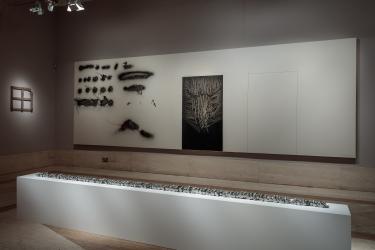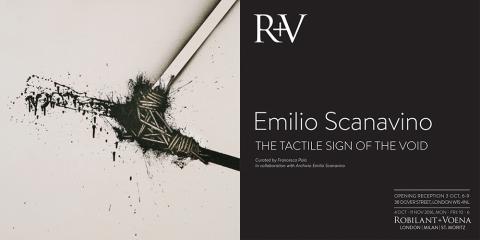In October ROBILANT+VOENA will present the first retrospective of Emilio Scanavino in London and the UK, 65 years after his first solo exhibition presented in this city in 1951. Curated by Francesca Pola and organised in collaboration with the Archivio Scanavino, the show will celebrate the work of Scanavino in the crucial creative decades of his activity, from the 1950s to the 1980s, which saw his affirmation as one of the pioneers and protagonists of an innovative poetics of the sign, declined between Informel, Spazialismo and a new concept of the void as field and concentration of human and material energy.
Scanavino’s revolutionary work first developed in the years immediately following World War II, in a direct dialogue with an international and vibrant artistic context, including Sebastian Matta and Alberto Giacometti, Francis Bacon and Graham Sutherland, and the artist of the CoBrA movement (Asger Jorn, Karel Appel and Corneille in particular). It was the time when Lucio Fontana and Alberto Burri were developing their revolutionary experimentations with space and matter, overcoming the traditional notions of painting and sculpture into a new direct relationship with the world. Fontana himself was also a very close friend to the artist, as it is also testified by Scanavino’s Necrologio per Fontana (Obituary for Fontana), 1968, created on the occasiono of his death and exhibited in this show at Robilant + Voena.
In this context, Scanavino’s choose the sign as his privileged mean of expression in painting, like other artists from this period as Giuseppe Capogrossi, Tancredi, Wols, Marc Tobey. Scanavino’s sign, however, is characterized by a distinctive human quality: it is the concentration of a gesture intended to penetrate the meaning of reality, investigating the void as the space for concentration of material energy of man in relationship to the world.
Scanavino’s practice aimed at overcoming the traditional notion of abstraction as either lyrical, surreal or constructive, trying to embody these different roots into a new relationship of the image with reality: he did so by using the pictorial sign as a gesture of knowledge, as a way of appropriating the universe mediated by his interiority, by touching the void where energy connects men and things. Across the decades, his unparalleled pictorial quality exercised in the continuous study of Renaissance painting and Italian Old Masters tradition, developed parallel to the poetics of Informel and Spazialismo in the 1950s, to the zeroing of the surface and the discovery of a new space in the 1960s, to the conceptual and analytical trends of the 1970s, to the expressive rediscovery of painting in the 1980s: always proposing his unique solution to the interpretation of his own time.
The exhibition will bring together pivotal examples of Scanavino’s work in investigating his tactile relationship with the world, through pieces related to key moments in his international artistic course. The first work in the show is Matrimonio bianco (White Wedding), 1951, which he exhibited in London in a joint solo show with Sarah Jackson, visited by Henry Moore at the time, and will also take to his participation in the crucial exhibition “This is Tomorrow” at the Whitechapel Gallery in London (1956). Another seminal work, All’origine (At the Origin), 1957, was presented in his solo room at the Venice Biennale from 1958; it is exhibited together with Omaggio al Maestro (Homage to the Master), 1962, a 3 meters masterpiece which Scanavino explicitly linked to Leonardo da Vinci’s experimentation with colours, recreating the same chromatic mixture described in his Taccuini (Notebooks).
La porta (The Door), 1977, six meters long, is one of the largest pieces Scanavino ever created: it is symbolic of his investigation of geometry and architecture archetypes characterizing his exploration of the void as a threshold to the infinite; next to it, is Colonna vertebrale (Spinal Column), 1969, his largest sculpture. They are both exhibited for the first time outside of Italy on this occasion.
Other crucial pieces, such as Geometria malata (Sick Geometry), 1967, Pittura 4 (Painting 4), 1971, Modificazione di un lato del quadrato (Modification of a Side of the Square), 1973, La scala impossibile (The Impossible Staircase), 1974, Avvenimento (Event), 1981, La meteora (The Meteor), 1982 feature Scanavino’s intertwined imagery of ritual archetypes and geometry, organic and rational, expression and rarefaction.
The last room of the exhibition presents, for the very first time ever, a rare and precious selection of sculptures from the 1950s and 1960s, such as Le uova mai schiuse di Hiroshima (The Never Hatched Eggs from Hiroshima), 1969, presented together with his drawn photographs from the early 1970s, showing the germination of Scanavino’s pictorial and plastic ideas.
This selection of about 35 works, including some unpublished and never before exhibited pieces from Italian private collections, will be the core of the exhibition: in demonstrating the outstanding wealth of his creative output, the show will reaffirm the role played by Scanavino in the development of modern and contemporary art internationally.
The exhibition will be accompanied by a 200 page book, written and edited by Francesca Pola, published by Marsilio Editore. Based on extensive studies of Scanavino’s work, with over 160 images of paintings, historical photos and documents, it will include a selection of critical historical writings and an iconographic mapping of selected works in museums around the world.



